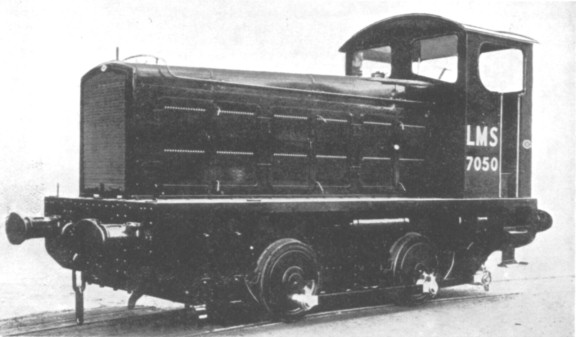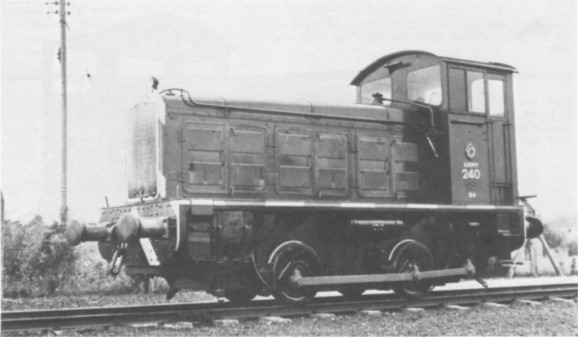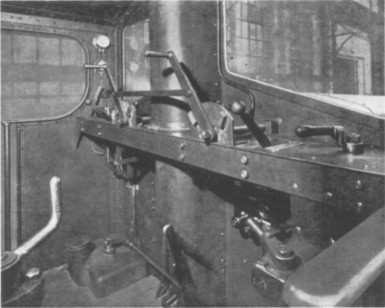
| THE INDUSTRIAL RAILWAY RECORD |
© OCTOBER 1973 |
ARMY 240
G. ARNOTT
War Department locomotives have become an accepted part of the industrial scene. Hence no apology is made for drawing attention to one example of diesel-mechanical shunter which has now been in service for something approaching forty years. The locomotive in question is Drewry 25½ ton 0‑4‑0 number 2047 which is still in active service with the Ministry of Defence. The story really begins in the early part of 1933 when the LMS Railway placed pilot orders for a total of eight diesel-mechanical shunters of 150-200hp for trial and evaluation. A brief summary of these locomotives, which carried running numbers 7050‑57, is given below.
7050. Drewry 2047 with an Allen 8‑cylinder 180hp engine, hydraulic coupling, and Wilson four speed pre‑selective epicyclic gearbox. Actually built by the English Electric Co Ltd, works number 847.
7051. Hunslet 1697, the maker's original standard gauge diesel prototype completed in February 1932 and taken over by the LMSR in the following year. It was fitted with a M.A.N. 150hp engine, Hunslet clutch and pre‑selective layshaft type gearbox.
7052. Hunslet 1721 of generally similar type to 7051 but fitted with an 8‑cylinder 150hp McLaren-Benz engine.
7053. Hunslet 1723 with Brotherhood-Ricardo 6‑cylinder sleeve valve 150hp engine, hydraulic coupling, and epicyclic gearbox having external brake drums, evolved at David Brown's works.
7054. Hunslet 1724 with a Paxman-Ricardo 180/200hp engine, fluid coupling, and three speed transmission incorporating a Humfrey-Sandberg clutch.
7055 and 7056. Hudswell Clarke D580 and D581 respectively, with 150hp Mirrlees-Ricardo engines, fluid coupling, and three speed layshaft type transmission, with axle mounted final drive in place of jackshaft.
7057. Harland & Wolff build of 150hp rating with maker's blower-scavenged two cycle engine (built under licence from the Danish firm of Burmeister & Wain), fluid coupling, and two speed constant mesh gearbox.

Drewry 2047 as delivered new to the LMSR. (collection G. Arnott)
All were 0‑6‑0's with the exception of 7050. Weights varied from 21 tons (7051) to 30 tons (7054) and all entered traffic in 1934, 7050 being one of the first in April of that year. From the outset none of the locomotives stood much of a chance in the climate and general lack of facilities then existing. All enjoyed fairly chequered careers - none more so than 7055, 7056, and 7057 - and having decided upon an extensive 350hp diesel-electric shunter programme in the late 1930's the LMSR felt no compunction in unloading the majority of their diesel-mechanicals on to the War Department in 1943. The ultimate fate of the majority is unknown to the writer but few are thought to have survived the war. Of two that did, probably the best known is Hunslet 1697 which, after serving with the War Department as WD 70027, worked for London & Thames Haven Oil Wharves Ltd in Essex before achieving honourable retirement on the Middleton Railway in Yorkshire. The other
– and relatively unknown – survivor is Drewry 2047, the subject of these notes.Since 2047's basic design remained unchanged in the many hundreds of Drewry shunters subsequently delivered to industry and railways over the ensuing thirty years, some details of her construction and history are not out of place. As built she was fitted with a prototype Allen direct injection engine arranged for electric starting, the only one of the eight locomotives to be so fitted. Transmission comprised a Vulcan Sinclair rigid traction type hydraulic coupling in conjunction with a four speed Wilson epicyclic gearbox having pneumatic operation and manufactured at ENV's Willesden works. The reverse and final drive unit was by Bostock & Bramley incorporating a layshaft reverse and worm final reduction. Based at Irlams o'th'Height, 7050 worked initially at Agecroft and then at Salford goods depot from 1936 onwards. The original cab was made fully enclosed after the first few months of service but the duplicated controls still remain as first designed and detailed at English Electric's Dick Kerr (Preston) works with whom Drewry were associated from 1930 to 1941.
Trouble was almost entirely confined to the engine which showed many endearing traits including, latterly, that of throwing connecting rods! Derby Works produced several replacements but by the time 7050 was withdrawn from Stanlow in 1942 following the fourth rod failure the engine was virtually beyond repair. On the other hand the CAV electric starting compared favourably with the compressed-air or auxiliary petrol engine starting employed on the other locomotives and is now of course universal for normal applications.

The fully enclosed cab appears to be the only major external change on Drewry 2047, seen here as ARMY 240 at West Moors Depot on 4th August 1972. (A. E. Beare)

Interior of the cab of Drewry 2047 showing the dual controls. (collection G. Arnott)
The Allen engine was replaced by a Gardner 6L3 153hp of the type then in use on the standard WD 21‑tonners. As the Allen had been of anti-clockwise rotation it was not possible to retain the original change-speed gearbox; this was therefore replaced by a Wilson SE‑type direct air operated unit again fitted to the standard 153hp WD's. The original reverse unit was retained however and the conversion was carried out by Vulcan Foundry Ltd in 1944, the rebuilt locomotive commencing work in February 1945 at Feltham Central Ordnance Depot bearing the number WD 70224.
Sometime during the early post-war period she was renumbered WD 846 in which guise she worked at West Hallam (from October 1953), Stirling (from August 1956 to May 1957); then after a six weeks sojourn at Bicester Workshops she worked at Hilsea from June 1957 until 1961. From April 1961 she was at Bicester awaiting the fitting of a new worm gear to the final drive: in November of that year she emerged to work at Elstow and then moved in April 1964 to her present location at West Moors Supply Depot in Dorset where she continues to meet all demands made upon her.
The makers of the final drive had some difficulty in producing the replacement worm gearing for the then 27‑year-old unit in 1961, and any failure in the present set will mean the final withdrawal of the locomotive
– now numbered ARMY 240 – since standardisation has been largely achieved within the MoD locomotive fleet. Nevertheless it is hoped that this day is still far off and that Drewry 2047 will still be amongst us to celebrate her fortieth anniversary in April 1974.We regret to record the death of the author earlier this year shortly after this article was received for publication.
'Tramways [in Paris] are taking up a good deal of attention. The idea has been started to throw open a competition for the best type of tramway locomotive. That of Larmanjat was tried at the end of last month on the "Tramway Nord," with results qualified by one or two defects. It is not considered strong enough for independent use, but is recommended as an auxiliary to horse power. This would make it a steam engine helped out with horseflesh. The "Tramways Sud" are about to try a fresh experiment with Harding's locomotive, which has been improved since the date of the former experiments.' ("Iron," 10th June 1876. Keith Clingan related in RECORD 13 (Vol 2, page 34) that G. Palmer Harding was a representative of Merryweather & Sons, steam tram locomotive manufacturers. — KPP)